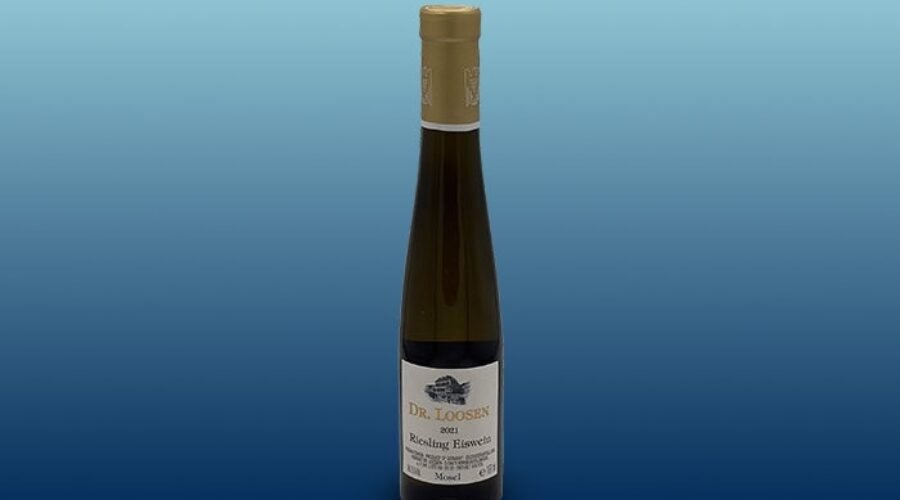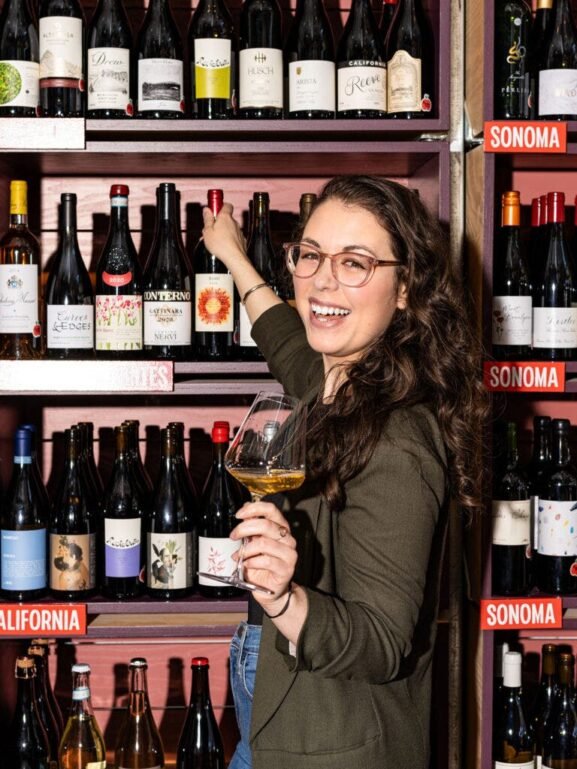Get to Know Ice Wine, the Intensely Sweet, Painstakingly Hard-to-Make Dessert Wine
Call it eiswein (if you speak German), icewine (if you’re Canadian—it’s trademarked) or ice wine (if you’re American); whatever the nomenclature, the intensely sweet, painstakingly hard-to-make dessert wine that conjures images of wooly sweaters and warm fires is an indulgent anomaly in the wine world.
Unlike other “stickies” like Sauternes or Tokaji, ice wine grapes are not affected by the noble rot, Botrytis cinerea. And unlike dry table wines, they’re not harvested in the autumn, but in the dead of winter, starting in December.
If the weather cooperates and temperatures remain consistently below freezing—which feels increasingly rare in the age of climate chaos—an ice wine harvest is a surefire way to ruin a wine picking teams’ holiday plans. Off they trudge to the vineyards, often in the middle of the night, to freeze their tushes off while hand-picking hard-as-rocks grapes (those that haven’t been taken by critters, that is).
Extreme Concentration, Slow Fermentation
After harvest, the ultra-ripe frozen berries are quickly and laboriously pressed. The water inside them freezes, but the sugar, acids and solids do not, so the precious little liquid eked out is extremely concentrated.
It can take up to six months to ferment to a final alcohol level of around 10%. The resulting “liquid gold” is rich, viscous and sweet, with oodles of dried fruit and honey flavors.
On average, these bottles boast 220 grams of sugar per liter—we’re talking double that of a can of soda—lifted by tangy acidity.
Master of Wine Jancis Robinson once described good ice wine as tasting like “a cross between the purest form of grape juice and a slap in the face, so vibrant is the acidity.”
Frosty Hardy, Aromatic Grapes From Freezing Climates
Ice wine (not to be confused with iced wine, where late harvest grapes are commercially frozen after being picked) is made from a range of cold hardy, aromatic varieties like Vidal Blanc (especially in Canada and the U.S.), Riesling and Gewürztraminer. It can also occasionally be found in red form, made from varieties like Cabernet Franc.
In Europe, Germany leads the eiswein charge, with Austria at its heels, but can be found at small scale in most of the continent’s chillier countries.
As Europe warms, Canada now reigns as the world’s largest ice wine producer.
In the U.S., New York State rules a frosty roost, although the style is crafted across many northern states, including Michigan, Ohio, Pennsylvania and Washington.
China has also emerged as a major ice wine player, produced in comparatively large quantities in the country’s northern Liaoning and Heilongjiang provinces from longstanding hybrid varieties commonly used in North America, like Vidal Blanc.
Because of its high risk, little reward nature, ice wine can be costly to produce and purchase. Sold in half bottles, it retails for anywhere between $30–$150 a pop, making it a treat to savor for special occasions or to sip slowly, well chilled, with a cheese board or cookie plate.
Here are four top ice wine regions to wrap your mittens around:
Germany
While mentions of using frozen grapes for wine production appear as far back as Roman times, eiswein as we know it started by accident in 1794 in Germany’s Franconia region when farmers were forced to make the best of an unexpected frost. However, it remained a rare beast until the 1960s when production ramped up thanks to the invention of the pneumatic press and other technological advancements that made production easier..
Made primarily from Riesling, Germany legally requires temperatures to drop below 19.4° Fahrenheit (-7°C) before eiswein grapes can be picked. Although these temperatures aren’t as common as they once were, when a good freeze does hit, producers across Germany’s 13 wine regions craft some of the finest examples of eiswein in the world.
Wine Enthusiast recommends:
Dr. Loosen 2021 Estate Eiswein Riesling (Mosel)
Very pure and succulent, with the tropical fruit and lemon aromas and flavors getting a boost from its racy structure. Fuller in body and very sweet with a long spicy, zingy acidity. Fine harmony and length. Drink now–2045. 93 Points— Aleks Zecevic
$40
Tasting House
let adType_67a1390831dba = “leaderboard”;
// Create the element
let script_67a1390831dba = document.createElement(“script”);
script_67a1390831dba.innerHTML = `
window.googletag = window.googletag || {cmd: []};
googletag.cmd.push(function() {
var mapping;
// Size mapping for leaderboard ads
var lbmapping = googletag.sizeMapping()
.addSize([1024, 0], [[970, 250], [970, 90], [1, 1], [728, 90]])
.addSize([728, 0], [[728, 90], [1, 1]])
.addSize([320, 0], [[1, 1], [300, 50], [300, 100], [320, 50], [320, 100]])
.addSize([0, 0], [[1, 1], [320, 50]])
.build();
// Size mapping for med rectengle ads
var medrecmapping = googletag.sizeMapping()
.addSize([1024, 0], [[300, 600],[300, 250]])
.addSize([728, 0], [300, 250])
.addSize([320, 0], [[1, 1],[300, 250]])
.addSize([0, 0], [[1, 1], [300, 250]])
.build()
//var lbSlots = [[[320, 100], [728, 90], [300, 100], [1, 1], [300, 50], [970, 250], [320, 50], [970, 90]]];
//var medrecSlots = [[300, 600], [1, 1], [300, 250]];
mapping = adType_67a1390831dba == ‘leaderboard’ ? lbmapping : medrecmapping;
googletag.defineSlot(‘/39808611/article_page/article_leaderboard_1’, [],
‘div-gpt-ad-67a1390831dba’).addService(googletag.pubads()).defineSizeMapping(mapping);
googletag.pubads().enableSingleRequest();
googletag.pubads().collapseEmptyDivs(); //maybe optional
googletag.pubads().refresh(); //maybe optional
googletag.enableServices();
});
`;
//checking to see if script is inserted in the header successfully
if (document.head.appendChild(script_67a1390831dba)) {
//variable holding the rendering body
document.getElementById(“gptBodySection-67a1390831dba”).innerHTML = `
googletag.cmd.push(function() { googletag.display(div-gpt-ad-67a1390831dba); });
`;
}
Austria
Austria, like Germany, has been producing “noble” sweet wines called Trockenbeerenauslese for over 500 years, but ice wine is a relatively new phenomenon. The first was produced from vineyards near Lake Neusiedl in Burgenland in 1971. Today, when the weather cooperates, ice wines are made across most Austrian wine growing regions, including in Niederösterreich, Wien and Steiermark.
Wine Enthusiast recommends:

Zantho 2020 Eiswein Grüner Veltliner (Burgenland)
This is becoming slightly oxidative, with toasted hazelnut and baked apple pie notes underscored by high acidity, which gives balance to the sweetness. Peach jam and dried apricot flavors take over and linger on the finish. 89 Points — A.Z.
$ Varies
Wine-searcher
Canada
It was bound to happen. As soon as German and Austrian immigrants realized Canada’s warm, sunny summers and long, cold winters were ideal for grape ripening and then freezing, they couldn’t help themselves.
Icewine was first produced commercially by Ontario-based Inniskillin winery (co-owned by Austrian Karl Kaiser) in 1984. Winning a prestigious award in 1991 put Inniskillin’s—and Canada’s—icewine on the world’s radar.
By the early 2000s, the country surpassed Germany to become the world’s largest icewine producer. Ontario, and particularly the Niagara Peninsula, produces the lion’s share, but the famed dessert wine is also made in British Columbia, Quebec and Nova Scotia.
Wine Enthusiast recommends:

Reif Estate 2021 Grand Reserve Icewine Vidal (Niagara River)
$ Varies
Wine-searcher

Jackson-Triggs 2022 Vidal Icewine Vidal (Niagara Peninsula)
$28
Total Wine & More

Inniskillin 2021 Sparkling Vidal Icewine Vidal (Niagara Peninsula)
Spine-tingling acidity and a creamy, viscous texture make for a heck of a nice combination. This wine has aromas of yellow apple, pear tart, butterscotch and treacle. Frisky little bubbles attempt to emerge from thick flavors of lychee and pear gelato, with a touch of cinnamon. Editors’ Choice. 95 Points — M.A.
$88
Blackwell’s Wines & Spirits

Cave Spring 2023 Icewine Riesling (Lincoln Lakeshore)
The wine’s golden aromas of yellow apples and juniper brush up against the earthy mineral scent of a high desert rain. This is a tick, viscous texture to revel in before surrendering to flavors like lemon, orange marmalade and brioche slathered with clover honey. What a ripping good icewine. Editors’ Choice. 96 Points — M.A.
$65
Binny’s Beverage Depot

Inniskillin 2022 Icewine Riesling (Niagara Peninsula)
Golden Delicious apples are joined by aromas of yarrow, butter and the lightest wisp of petrol. A texture as rich and voluptuous as Troy Polamalu’s wavy locks is home to a rich mix of a sweet and creamy Champagne mango, toffee and thyme. A surprising amount of juicy acidity only adds to the enjoyment of this icewine. 94 Points — M.A.
$60
Great Estates
let adType_67a1390835041 = “leaderboard”;
// Create the element
let script_67a1390835041 = document.createElement(“script”);
script_67a1390835041.innerHTML = `
window.googletag = window.googletag || {cmd: []};
googletag.cmd.push(function() {
var mapping;
// Size mapping for leaderboard ads
var lbmapping = googletag.sizeMapping()
.addSize([1024, 0], [[970, 250], [970, 90], [1, 1], [728, 90]])
.addSize([728, 0], [[728, 90], [1, 1]])
.addSize([320, 0], [[1, 1], [300, 50], [300, 100], [320, 50], [320, 100]])
.addSize([0, 0], [[1, 1], [320, 50]])
.build();
// Size mapping for med rectengle ads
var medrecmapping = googletag.sizeMapping()
.addSize([1024, 0], [[300, 600],[300, 250]])
.addSize([728, 0], [300, 250])
.addSize([320, 0], [[1, 1],[300, 250]])
.addSize([0, 0], [[1, 1], [300, 250]])
.build()
//var lbSlots = [[[320, 100], [728, 90], [300, 100], [1, 1], [300, 50], [970, 250], [320, 50], [970, 90]]];
//var medrecSlots = [[300, 600], [1, 1], [300, 250]];
mapping = adType_67a1390835041 == ‘leaderboard’ ? lbmapping : medrecmapping;
googletag.defineSlot(‘/39808611/article_page/article_leaderboard_2’, [],
‘div-gpt-ad-67a1390835041’).addService(googletag.pubads()).defineSizeMapping(mapping);
googletag.pubads().enableSingleRequest();
googletag.pubads().collapseEmptyDivs(); //maybe optional
googletag.pubads().refresh(); //maybe optional
googletag.enableServices();
});
`;
//checking to see if script is inserted in the header successfully
if (document.head.appendChild(script_67a1390835041)) {
//variable holding the rendering body
document.getElementById(“gptBodySection-67a1390835041”).innerHTML = `
googletag.cmd.push(function() { googletag.display(div-gpt-ad-67a1390835041); });
`;
}
New York
Like Germany, New York and Riesling go together like cheese and crackers, so it’s no surprise that the northeast state is also a hot spot for ice wine production (although the dominant variety for the New York version is Vidal Blanc).
The state’s northwestern regions—the Finger Lakes, Lake Erie and Niagara Escarpment—all get cold enough winters to produce ice wine fairly consistently. While the number of producers crazy enough to attempt this appendage-numbing style changes year-to-year, it’s an important enough part of New York wine culture to warrant a festival dedicated to celebrating the Empire State’s now-famed ice wine scene.
Wine Enthusiast recommends:

Wagner 2022 Ice Vidal (Finger Lakes)
Nectar-like, in both color and style, there’re rich, heady aromas of honeycomb, baked apple and pear, and an earthier note, like truffles. It’s intensely sweet and blankets the tongue unctuously, but then is sliced with a razor blade of acidity that makes it easy to reach for another sip. 92 Points — Christina Pickard
$30
Wagner Vineyards

Lamoreaux Landing 2022 Estate Bottled Ice Riesling (Finger Lakes)
A bright gold hue, this Riesling-based ice wine weaves together aromas of honey, beeswax, stone fruit and citrus rind. The palate is sweet and concentrated, a satiny blanket over the tongue, but there’s a lovely acidity that washes across the midpalate, and a lingering candied citrus tang on the long finish. 93 Points — C.P.
$40
Lamoreaux Landing

Sheldrake Point 2020 Estate Bottled Ice Wine Riesling (Finger Lakes)
A vibrant buttercup color, it’s intensely perfumed with notes of melted butter (the kind over cinema popcorn), butterscotch and crème caramel. The viscous palate, while sweet, is less confected than the aromas imply, thanks to big lift to acidity to freshen. Drink with a nutty, dried fruit-based dessert. 90 Points — C.P.
$60
Sheldrake Point
More Dessert Wine Coverage
- Your definitive guide to sweet wines.
- Vin santo, the sweet “wine of saints,” is poised for a revival.
- Everything you need to know about late-harvest wine.
- When in Rome, dunk cookies in wine.
- Can sweet wine’s U.S. image be rehabilitated?
- Sugar high: a quick guide to sweet red wine.

From the Shop
Find Your Wine a Home
Our selection of sweet wine glasses is the best way to enjoy the wine’s subtle aromas and bright flavors.
The post Get to Know Ice Wine, the Intensely Sweet, Painstakingly Hard-to-Make Dessert Wine appeared first on Wine Enthusiast.


